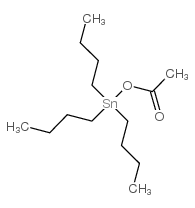56-36-0
| Name | tributylstannyl acetate |
|---|---|
| Synonyms |
Stannane,(acetyloxy)tributyl
tributyltin acetate (acetyloxy)tributyl-stannane Stannane,acetoxytributyl MFCD00015228 Acetoxytributyltin EINECS 200-269-6 Tributylacetoxystannane Tin,acetoxytributyl tin tributylacetate Tribuyltin acetate Tri-n-butyltin acetate Acetoxytributylstannane |
| Density | 1,27 g/cm3 |
|---|---|
| Boiling Point | 120 °C / 2mmHg |
| Melting Point | 80-83 °C(lit.) |
| Molecular Formula | C14H30O2Sn |
| Molecular Weight | 349.08800 |
| Flash Point | 120 °C |
| Exact Mass | 350.12700 |
| PSA | 26.30000 |
| LogP | 4.89530 |
|
Section 1: Product Identification Chemical Name:Tri-n-butyltin acetate, 98% CAS Registry Number:56-36-0 Formula:(C4H9)3SnOOCCH3 EINECS Number:200-269-6 Chemical Family:organotin compound Synonym:Acetoxytributylstanne, Tributylstannyl acetate, Tri-n-butyltin acetate
Section 2: Composition and Information on Ingredients IngredientCAS NumberPercentACGIH (TWA)OSHA (PEL) Title Compound56-36-0100%0.1mg/m30.1mg/m3 Section 3: Hazards Identification Organo tin compounds may act as delayed poisons, causing headache, dizziness; psycho-neurologic Emergency Overview: disturbances; sore throat, vomiting; urine retention; vision impairment; skin burns, liver and kidney damage. Primary Routes of Exposure:Ingestion, inhalation, skin, eyes Eye Contact:Causes irritation of the eyes. Skin Contact:Causes irritation of the skin. Prolonged contact may dry the skin and lead to rashes or more severe irritation. Irritating to the nose, mucous membranes and respiratory tract. High doses may cause long term neurological Inhalation: damage. Delayed and permanent psycho-neurologic disturbances; impairment of vision, unsteadiness, nausea and Ingestion: vomiting. Toxic if swallowed. Irritating to skin, eyes and mucous membranes. Ingestion of certain organotin compounds may cause delayed Acute Health Affects: poisoning (4 days) with cerebral edema causing damage to the central nervous system. Repeated exposure to certain organic tin compounds may cause problems with vision, skin, respiratory Chronic Health Affects: system, central nervous system, liver, kidneys, urinary tract, and blood. NTP:No IARC:No OSHA:No SECTION 4: First Aid Measures Immediately flush the eyes with copious amounts of water for at least 10-15 minutes. A victim may need Eye Exposure: assistance in keeping their eye lids open. Get immediate medical attention. Wash the affected area with water. Remove contaminated clothes if necessary. Seek medical assistance if Skin Exposure: irritation persists. Remove the victim to fresh air. Closely monitor the victim for signs of respiratory problems, such as difficulty Inhalation: in breathing, coughing, wheezing, or pain. In such cases seek immediate medical assistance. Seek medical attention immediately. Keep the victim calm. Give the victim water (only if conscious). Induce Ingestion: vomiting only if directed by medical personnel. SECTION 5: Fire Fighting Measures Flash Point:no data Autoignition Temperature:no data Explosion Limits:no data Extinguishing Medium:carbon dioxide or dry powder Fire fighters should be equipped with a NIOSH approved positive pressure self-contained breathing apparatus Special Fire Fighting Procedures: and full protective clothing. Hazardous Combustion andcarbon monoxide, carbon dioxide, soot, organic fumes and tin compounds. Decomposion Products: Unusual Fire or Explosion Hazards: No unusual fire or explosion hazards. SECTION 6: Accidental Release Measures Small spills can be mixed with vermiculite, ground limestone, sodium carbonate or other suitable Spill and Leak Procedures: noncombustible adsorbent and swept up. SECTION 7: Handling and Storage Handling and Storage:Store in a cool, dry, well ventilated area away from heat and direct sunlight. Keep containers tightly sealed. SECTION 8: Exposure Controls and Personal Protection Eye Protection:Always wear approved safety glasses when handling a chemical substance in the laboratory. Skin Protection:Wear protective clothing and gloves. Consult with glove manufacturer to determine the proper type of glove. Ventilation:Work with this product in a well-ventilated area, preferably a fume hood. If ventilation is not available a respirator should be worn. The use of respirators requires a Respirator Respirator: Protection Program to be in compliance with 29 CFR 1910.134. Ventilation:Work with this product in a well-ventilated area, preferably a fume hood. Additional Protection:No additional protection required. SECTION 9: Physical and Chemical Properties Color and Form:white pwdr. Molecular Weight:349.08 Melting Point:87° Boiling Point:no data Vapor Pressure:no data Specific Gravity:1.27 Odor:not determined Solubility in Water:insoluble SECTION 10: Stability and Reactivity Stability:moisture sensitive Hazardous Polymerization:no hazardous polymerization Conditions to Avoid:none Incompatibility:strong oxidizing agents and halogens Decomposition Products:carbon monoxide, carbon dioxide, tin oxide, organic fumes. SECTION 11: Toxicological Information Oral (rat); LD50: 99 mg/kg. Intraperitoneal (rat); LDLo: 10 mg/kg. Oral (mouse); LD50: 46 mg/kg. Intravenous (mouse); LD50: 180 mg/kg. Oral (rabbit); LDLo: 40 mg/kg. Oral (guinea pig); LDLo: 20 mg/kg. Administration RTECS Data:onto the skin (mammal-species unspecified); LD50: >5 gm/kg. Unreported (mammal-species unspecified); LD50: 500 mg/kg. Oral (rat); TDLo: 630 mg/kg/12W-C. Oral (rat); TDLo: 176 mg/kg. Oral (rat); TDLo: 176 mg/kg. Carcinogenic Effects:No data available Mutagenic Effects:No data available Tetratogenic Effects:Possible reproductive effector SECTION 12: Ecological Information Ecological Information:No information available SECTION 13: Disposal Considerations Disposal:Dispose of according to federal, state, and local regulations. SECTION 14: Transportation Shipping Name (CFR):Organotin compounds, solid, N.O.S. Hazard Class (CFR):6.1 Additional Hazard Class (CFR):NA Packaging Group (CFR):III UN ID Number (CFR):UN# 3146 Shipping Name (IATA):Organotin compound, solid, N.O.S. Hazard Class (IATA):6.1 Additional Hazard Class (IATA):NA Packaging Group (IATA):III UN ID Number (IATA):UN# 3146 SECTION 15: Regulatory Information TSCA:Not listed in the TSCA inventory. SARA (Title 313):Title compound not listed. Second Ingredient:none SECTION 16 - ADDITIONAL INFORMATION N/A |
CHEMICAL IDENTIFICATION
HEALTH HAZARD DATAACUTE TOXICITY DATA
|
| Hazard Codes | T,N |
|---|---|
| Risk Phrases | 21-25-36/38-48/23/25-50/53 |
| Safety Phrases | S35-S36/37/39-S45-S60-S61 |
| RIDADR | UN 3146 6.1/PG 2 |
| WGK Germany | 3 |
| RTECS | WH5775000 |
| Packaging Group | III |
| Hazard Class | 6.1 |
